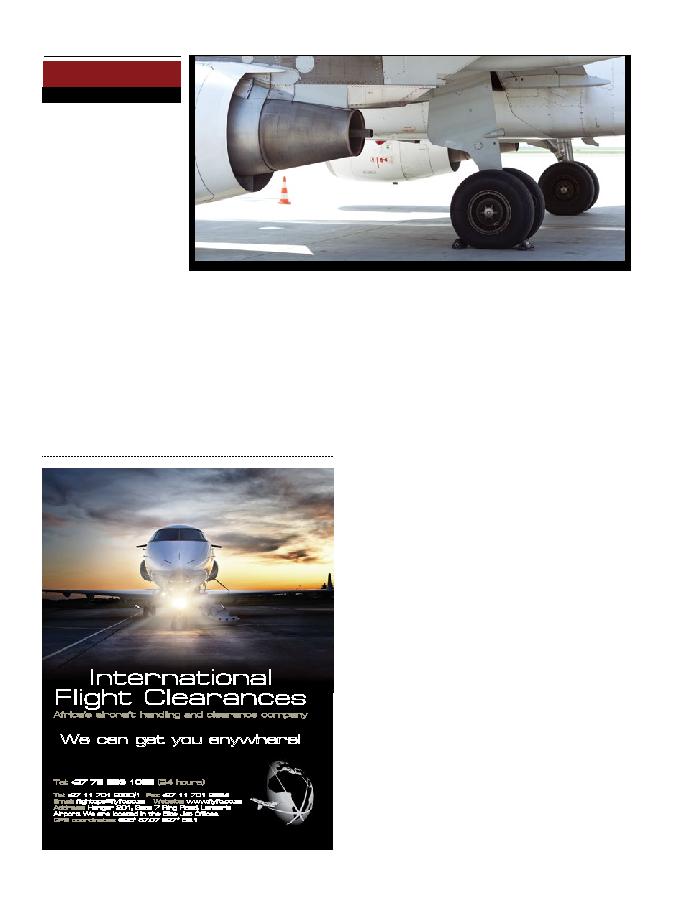
14
GA
/ Vol. 5 / No.4 / APRIL 2013
International Flight Clearances
Tel:
+27 76 983 1089
(24 hours)
Tel:
+27 11 701 2330/1
Fax:
+27 11 701 2334
Email:
flightops@flyifc.co.za
Website:
www.flyifc.co.za
Address:
Hanger 201, Gate 7 Ring Road, Lanseria
Airport. We are located in the Elite Jet Offices.
GPS coordinates:
S25
º 57.07 E27 º 58.1
We can get you anywhere!
Advert 21 Nov.indd 1
5/28/12 6:27 PM
Aircraft Products
Aircaft tyres
Lets start off with a few general
comments re: tyres: Pneumatic tyres
are manufactured in about 450 tyre
factories around the world. Over
one billion tyres are manufactured
annually, making the tyre industry
a major consumer of natural rubber.
Tyre production starts with bulk
raw materials such as rubber,
carbon black, and chemicals and
produces numerous specialized
components that are assembled
and cured. Many kinds of rubber
are used, the most common being
styrene-butadene copolymer. This
article describes the components
assembled to make a tyre, the various
materials used, the manufacturing
processes and machinery.
Tread
The tread is the part of the tyre that
comes in contact with the road/
runway surface. The portion that is
in contact with the road at a given
instant in time is the contact patch.
The tread is a thick rubber, or rubber/
composite compound formulated
to provide an appropriate level of
traction that does not wear away
too quickly. The tread pattern is
characterized by the geometrical
shape of the grooves, lugs, voids and
sipes. Grooves run circumferentially
around the tire, and are needed
to channel away water. Lugs are
that portion of the tread design
that contacts the road surface.
Voids are spaces between lugs that
allow the lugs to flex and evacuate
water. Tread patterns feature non-
symmetrical (or non-uniform) lug
sizes circumferentially to minimize
noise levels at discrete frequencies.
Sipes are valleys cut across the tire,
usually perpendicular to the grooves,
which allow the water from the
grooves to escape to the sides in an
effort to prevent hydroplaning.
Treads are often designed to meet
specific product marketing positions.
High performance tires have small
void rations to provide more rubber
in contact with the road for higher
traction, but may be compounded
with softer rubber that provides
better traction, but wears quickly.
Mud and snow (M&S) tires are
designed with higher void ratios
to channel away rain and mud,
while providing better gripping
performance. Specialized tires will
always work better than general/
all purpose/all weather tires when
being used in the conditions the
specialized tires are designed for.
Tread Lugs and Voids
Tread lugs provide the contact surface
necessary to provide traction. As
the tread lug enters the road contact
area, or footprint, it is compressed.
As it rotates through the footprint
it is deformed circumferentially.
As it exits the footprint, it recovers
to its original shape. During the
deformation and recovery cycle
the tire exerts variable forces
into the vehicle. These forces are
described as Force Variation.
Tread voids provide space for the
lug to flex and deform as it enters and
exits the footprint. Voids also provide
channels for rainwater, mud, and
snow to be channeled away from the
footprint. The void ratio is the void
area of the tire divided by the entire
tread area. Low void areas have high
contact area and therefore higher
traction on clean, dry pavement.
Rain groove
The rain groove is a design element
of the tread pattern specifically
arranged to channel water away
from the footprint. Rain grooves are
circumferential in most truck tyres.
Many high performance passenger
tires feature rain grooves that are
angled from the center toward
the sides of the tyre. Some tire
manufacturers claim that their
tread pattern is designed to actively
pump water out from under the
tyre by the action of the tread
flexing. This results in a smoother
ride in different types of weather.
Sipe
Tread lugs often feature small
narrow voids, or sipes, that improve
the flexibility of the lug to deform as
it traverses the footprint area. This
reduces shear stress in the lug and
reduces heat build up. Testing of
identical siped and unsiped tires
showed measurable improvements
in snow traction and ice braking
performance, however diminishing
and extending braking distances
on wet and dry pavement by
a few feet on siped tyres.
Wear Bar
Wear bars (or wear indicators) are
raised features located at the bottom
of the tread grooves that indicate
the tire has reached its wear limit.
When the tread lugs are worn to
the point that the wear bars connect
across the lugs, the tires are fully
worn and should be taken out of
service. Most wear bars indicate
a remaining tread depth of 1.6
millimetres (0.063 in) and are
deemed "worn out" at that point.
Bead
The bead is that part of the tire
that contacts the rim on the wheel.
The bead is typically reinforced
with steel wire and compounded
of high strength, low flexibility
rubber. The bead seats tightly
against the two rims on the wheel
to ensure that a tubeless tire holds
air without leakage. The bead fit
is tight to ensure the tire does not
shift circumferentially as the wheel
rotates. The width of the rim in
relationship to the tire is a factor
in the handling characteristics
of an automobile, because the

